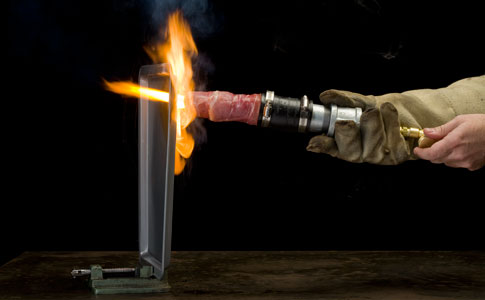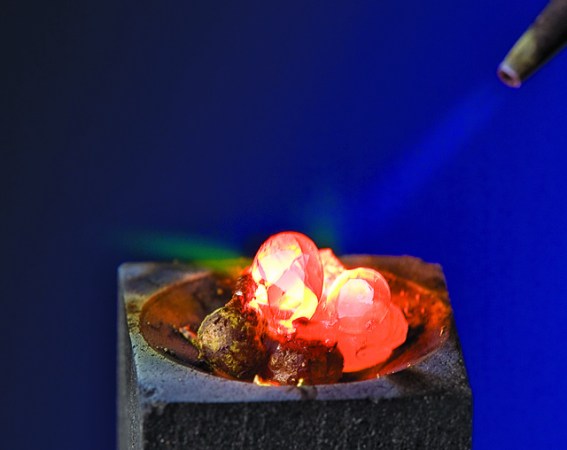

I recently committed myself to the goal, before the weekend was out, of creating a device entirely from bacon and using it to cut a steel pan in half. My initial attempts were failures, but I knew success was within reach when I was able to ignite and melt the pan using seven beef sticks and a cucumber.
No, seriously. The device I built was a form of thermal lance. A thermal lance, typically made of iron instead of bacon, is used to cut up scrap metal and rescue people from collapsed buildings. It works by blowing pure oxygen gas through a pipe packed with iron and magnesium rods. These metals are surprisingly flammable in pure oxygen, releasing a huge amount of heat as they are consumed. The result is a jet of superheated iron plasma coming out of the end of the pipe. For sheer destructive force, few tools match a thermal lance. But iron isn’t the only thing that’s flammable in a stream of pure oxygen.

Bacon is fattening because it contains a lot of chemical energy tied up in its proteins, and especially in its fat. You can release that energy either by digesting it or by burning it with a healthy supply of oxygen. The challenge isn’t creating the heat; it’s engineering a bacon structure strong enough to withstand the stress of a 5,000-degree-Fahrenheit bacon plasma flame.
Achtung! Theodore Gray is a scientist trained in lab safety procedures. Do not attempt this experiment at home. For more information on Gray’s scientific pursuits, visit his website.
I used prosciutto (Italian for “expensive bacon”) because it is a superior engineering grade of meat. I wrapped slices of it into thin tubes and baked them overnight in a warm oven to drive off all the water. Then I bundled seven of those together, wrapped them in additional slices, and baked the bundle again until it was hard and dry.

From table to torch

To make an airtight, less-flammable outer casing, I wrapped this fuel core with uncooked prosciutto before attaching one end of it to an oxygen hose. You can’t imagine the feeling of triumph when I first saw the telltale signs of burning iron: sparks bursting from the metal, and then a rush of flame out of the other side as I witnessed perhaps the first-ever example of bacon-cut steel. And the lance kept on burning for about a minute.
It turns out there are much easier ways to do this. For example, while researching how to build a vegetarian lance, I hit on the perfect pipe material—hollowed-out cucumbers. The pressure-containment capacity of a standard cucumber is remarkable, and the smooth skin makes it easy to create an airtight seal with the pipe delivering oxygen to the device. A cucumber packed with beef sticks will burn for almost two minutes, and a completely vegetarian version stuffed with breadsticks, though not quite as long-lasting, still produces a very impressive flame.
The lesson here is that food is a source of serious amounts of energy. Pure oxygen helps release it in a much shorter time than usual, but it’s really the chemical energy in the bacon that makes the steel pan burn. Whether it’s worth building a bacon lance to demonstrate this—well, only you can be the judge of that.







